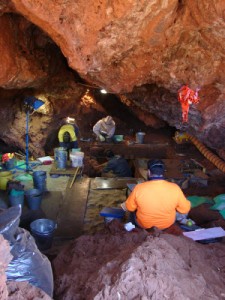Archive
Is Western Australia’s heritage compliance boom suddenly over?
To Boom or not to boom, that is the question.
Australia’s Resources and Energy Minister Martin Ferguson declared on 23 August 2012 that the country’s mining boom was over. This was one day after the world’s biggest miner BHP Billiton shelved two expansion plans – the Olypmic Dam open cut mine expansion in South Australia and the Port Hedland outer harbour expansion in Western Australia’s Pilbara region – each project valued at around $320 billion.

Archaeological salvage excavation at an iron mine site in the Pilbara (Photo: Guadalupe Cincunegui, ACHM).
These statements prompted some immediate flak from the mining and resources sector, while the Western Australian Premier Colin Barnett repeated his mantra that there never was a “boom”, it was just that his State has a healthy, expanding economy!Minister Ferguson and other senior Labor Government figures rapidly clarified his statement, saying that he was referring to the commodities boom being over, particularly with the international iron ore and coal prices dropping, while tens of billions of dollars in ongoing mining and energy development projects in Australia would continue on track.This is the point at which Australian heritage consultants could stop holding their breath and quaking every time they looked at a media financial report for more news of impending doom.
Heritage consulting in Australia is predominantly tied up with mining and energy developments and regional infrastructure development projects – which in turn are responses to growth through mining and energy developments. Minister Ferguson’s original announcement, coupled with BHP Billiton’s announcement and the resulting media blitz caused considerable angst among consulting firms still taking on new staff to push for bigger shares of mining-related heritage survey and impact-mitigation work – and for the growing numbers of local archaeology and anthropology graduates, as well as international ones on holiday-working visas, who are looking for work in the industry.
There has been some drop in available project work – cancellation of the BHP Billiton projects and some slowdowns in other companies’ projects due to credit and cost recalculations in the face of lower commodity prices. This has hit Queensland’s coal industry, though coal-seam gas projects so far seem unaffected. Overall though, everyone still seems to be maintaining their work flow on current projects. However, heritage services for development projects represent a finite block of work, and to maintain momentum, heritage consultancies need a constant flow of new projects. So while there appears to be enough work at the moment, we will still be all watching China in particular and the financial news in general, to see if the past continues to have a commercial future in Australia.
Heritage-only firms must market
Its list time in Canada, when many of the provincial lists of qualified archaeological firms get updated. Recent articles in Heritage Business Journal have noted a shift in market share away from heritage-only firms. In the draft of the current list of qualified Alberta archaeological consultants there are 27 companies listed: 19 of these were heritage-only firms and 8 were multidisciplinary firms. This listing also suggests that multidisciplinary firms have more staff (average of 2.8 vs. 1.8 for the heritage-only firms). There are three caveats here. First, I sorted the firms on my knowledge of what they do–they are not listed that way. Second, while more heritage-only firms have a single archaeologist, the number of staff on the list is not very consistent. Third, it should be noted that not all the firms on the list are actually in Alberta, in case readers are wondering how a single province supports 27 archaeology firms.
Archaeology, like many environmental services, is a requirement for some development approvals. Developers who do not know how to find an archaeologist are given the list of qualified firms. My hunch is that lists such as the Alberta Consultant’s List form the entire marketing plan for many small heritage-only firms. This raises the question of whether the reported switch to multidisciplinary firms is due to a customer desire for one stop shopping, or whether it is because multidisciplinary firms out-market and out-brand heritage only firms. Read more…
